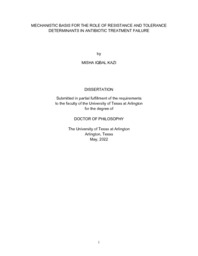
ATTENTION: The works hosted here are being migrated to a new repository that will consolidate resources, improve discoverability, and better show UTA's research impact on the global community. We will update authors as the migration progresses. Please see MavMatrix for more information.
Show simple item record
| dc.contributor.advisor | Boll, Joseph | |
| dc.creator | Kazi, Misha Iqbal | |
| dc.date.accessioned | 2022-06-28T15:10:31Z | |
| dc.date.available | 2022-06-28T15:10:31Z | |
| dc.date.created | 2022-05 | |
| dc.date.issued | 2022-05-09 | |
| dc.date.submitted | May 2022 | |
| dc.identifier.uri | http://hdl.handle.net/10106/30365 | |
| dc.description.abstract | Failure of antibiotics in treatment of nosocomial Gram-negative bacterial infections has created a substantial burden for global public health. The β-lactam class of antibiotics includes last resort carbapenems, which are used to combat multidrug resistant Gram-negative bacterial infections. Production of β-lactamase enzymes that degrade these antibiotics is the primary mechanism β-lactam resistance in Gram-negative bacteria. While FDA-approved serine-β-lactamase inhibitors are co-formulated with β-lactam antibiotics to prevent their inactivation during treatment, no metallo-β-lactamase inhibitors have been approved for clinical use. The first study employs an innovative antimicrobial discovery platform to identify peptide inhibitors against the New Delhi metallo-β-lactamase-1 (NDM-1), which is a concerning resistance enzyme that inactivates carbapenems. The activity of lead inhibitors to enhance carbapenem susceptibility was validated against NDM-1 encoded Enterobacteriaceae using minimum inhibitory concentration (MIC) and minimum bactericidal concentration (MBC) assays. Biochemical analysis using the chromogenic β-lactam analog nitrocefin and purified NDM-1 enzyme revealed direct binding of four peptide sequences to NDM-1. Kinetic studies showed that three of the four lead inhibitors competitively bound NDM-1, while one peptide demonstrated non-competitive inhibition. The translational potential of lead peptides was determined using MTT and hemolysis assays where all four inhibitors showed minimal hemolytic and cytotoxic activity against mammalian cell lines. These studies provide a starting point for optimization and development of potent metallo-β-lactamase inhibitors with strong translational potential.
While resistance is a major contributor to antibiotic treatment failure, growing evidence suggests that antibiotic tolerance also plays a significant role in bacterial evasion of antimicrobial therapeutics. Many clinically significant Gram-negative pathogens demonstrate spheroplast-mediated tolerance to carbapenems. The second study uses Enterobacter cloacae to identify determinants of carbapenem tolerance in Enterobacteriaceae. These studies highlight the importance of PhoPQ-dependent L-Ara4N (positively charged moiety) addition to lipid A for E. cloacae carbapenem tolerance. Our analysis also suggests that PhoPQ-mediated lipid A modification is a highly conserved carbapenem tolerance mechanism across Enterobacteriaceae. This novel role for the highly conserved PhoPQ TCS presumably protects spheroplasts during treatment by increasing outer membrane stability and integrity. The third study expands my work on tolerance into the nosocomial Gram-negative pathogen Acinetobacter baumannii. Global differential gene expression profile of tolerant A. baumannii was determined by RNA-sequencing analysis, which revealed increased expression of genes encoding efflux pumps, putative lipoproteins and lipoprotein transport machinery and downregulation of genes encoding outer membrane porins in meropenem treated versus untreated samples. Tn-seq was performed to pinpoint fitness determinants contributing to spheroplast-mediated carbapenem tolerance in A. baumannii. Subsequent validation and biochemical analysis demonstrated importance of outer membrane and peptidoglycan maintenance in A. baumannii carbapenem tolerance. These findings further emphasize the importance of maintaining outer membrane rigidity and stability for carbapenem tolerance and specifically spheroplast formation in Gram-negative bacteria.
The fourth study provides a detailed outline for a highly efficient Tn-seq method. This method relies on bacterial conjugation to generate saturated transposon insertion libraries and uses mechanical shearing for genomic DNA fragmentation which streamlines the entire method to provide robust and reproducible results. Together, these studies exploit innovative techniques to address important questions regarding clinical antibiotic treatment failure and provide novel targets for therapeutic development to potentially slow the spread of resistance and extend clinical efficacy of β-lactam antibiotics. | |
| dc.format.mimetype | application/pdf | |
| dc.language.iso | en_US | |
| dc.subject | Antibiotic treatment failure | |
| dc.subject | Gram-negative bacteria | |
| dc.subject | Antimicrobial peptides | |
| dc.subject | Metallo-β-lactamase inhibitors | |
| dc.subject | Antimicrobial resistance | |
| dc.subject | Antibiotic tolerance | |
| dc.subject | Transposon sequencing | |
| dc.title | MECHANISTIC BASIS FOR THE ROLE OF RESISTANCE AND TOLERANCE DETERMINANTS IN ANTIBIOTIC TREATMENT FAILURE | |
| dc.type | Thesis | |
| dc.degree.department | Biology | |
| dc.degree.name | Doctor of Philosophy in Quantative Biology | |
| dc.date.updated | 2022-06-28T15:10:32Z | |
| thesis.degree.department | Biology | |
| thesis.degree.grantor | The University of Texas at Arlington | |
| thesis.degree.level | Doctoral | |
| thesis.degree.name | Doctor of Philosophy in Quantative Biology | |
| dc.type.material | text | |
| dc.creator.orcid | 0000-0002-8676-070X | |
Files in this item
- Name:
- KAZI-DISSERTATION-2022.pdf
- Size:
- 11.90Mb
- Format:
- PDF
This item appears in the following Collection(s)
Show simple item record


